If you haven’t seen the two Rope-A-Dope short films on YouTube, take a moment right now and check them out. They are embedded in this article.
That was fun now, wasn’t it? If you know your martial arts and action cinema, you’ll see nods to The Good the Bad and the Ugly (1966), Kickboxer (1989), Battle Royale (2000), and countless Jackie Chan flicks. But what really shines is the fight choreography. The Rope-A-Dope shorts are the brainchild of Eric Jacobus, co-founder of The Stunt People, a stand-out group of aspiring action stars based primarily in the San Francisco Bay Area. For Rope-A-Dope 2, released just last week, Eric was a martial movie multitasker, taking on the roles of writer, director, fight choreographer, editor, and of course, star. Rope-A-Dope 2 was supported by the Tiger Claw Foundation, Tiger Claw’s non-profit charitable organization dedicated to promoting martial artists and assisting martial artists in achieving their goals. We spoke to Eric about his latest effort.
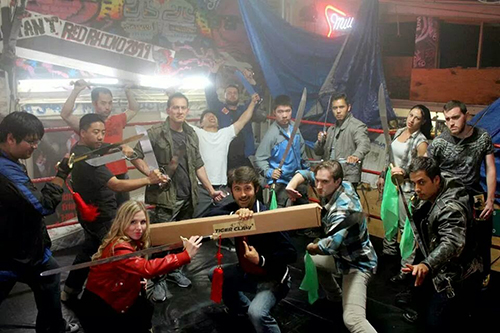
GC: For the sake of our readers, tell us a little about your martial arts background.
EJ: I started out taking Tae Kwon Do with Andy Leung in San Francisco in 2002. I went on to take Hapkido with Dennis Ruel, Ray Carbonel and Troy Carbonel soon after that. I was something of a late bloomer I guess, but I had been weightlifting since the age of 13 and did some gymnastics, so I was already a physical kid when I started. Andy and I used to practice flash kicks together at his gym before class!
GC: And tell us about The Stunt People - how did it begin, when did it begin, and why?
EJ: We were a small group of martial artists and acrobats who came together in Redding, CA back in 2001, and we wanted to contribute to the martial arts genre, which we felt was in peril in that lull between 1995 and 2001. So I formed The Stunt People with the simple philosophy - action people producing action films. I picked up filmmaking skills by reverse engineering how they made Hong Kong films, and with a knack for comedy I'd write up simple comedic action films that we shot over the weekend. We filmed something every weekend and completed something like 3 hours-worth of shorts that first year.
GC: How many times did you get hit in the head with a newspaper for Rope-A-Dope?
EJ: Seventy-three, give or take a few. I got hit in the nuts about 12 times. Those were way more painful. In Rope A Dope 2 it was similar. The hardest part of getting hit in the face (or the nuts) is trying not to flinch before impact, which is called "telegraphing." We use that term in fight choreography when someone blocks or reacts too early. Telegraphing ruins gags because the audience somehow instantaneously figures out the punchline before the gag even happens. The subconscious is pretty amazing if you think about it. The audience is way smarter and quicker than we give it credit for.
GC: The comparison to Groundhog Day (1993) is obvious. Was that the actual inspiration for Rope-A-Dope or was it something else?
EJ: Definitely. My partner Clayton Barber, who produced both films, and I wanted to mix Jackie Chan-style action, which my team's easily capable of doing, with a Groundhog Day story, starring a bumbling "tramp" like Charlie Chaplin used to play.
GC: The original Rope-A-Dope tagline ‘Wake, Fight, Repeat’ sounds a lot like the tagline for Edge of Tomorrow (2014) ‘Live, Die, Repeat’. What did you think when you heard that?
EJ: To our credit, we released Rope-A-Dope before we even heard of Edge of Tomorrow, but "Wake, Fight, Repeat" is a play on their subtitle. I ripped that off. In fact, I hope I get sued for it. It'll bring a lot of views!
GC: Why did you choose to go without dialogue for the Rope-A-Dope films?
EJ: We did film some dialog but cut it all out in the editing room. Jackie's best material is his physical humor. He's not a one-liner kind of guy. Chaplin and Keaton's best stuff is their silent physical comedy. Granted you can't do something like that in a feature film but after 14 years of people saying I do good physical comedy, it just made sense to focus on that.
GC: How long did it take to make Rope-A-Dope 2?
EJ: From concept to completion Rope-A-Dope 2 was a 9-month process. We had a few hiccups during shooting - reshoots, delays, getting robbed at gunpoint in West Oakland - and the editing process was arduous because of how complicated the plot was. Co-director Pete Lee and I screened the film at various stages to test audiences, and we'd measure their responses to various jokes, which helped us craft a well-paced action comedy that could resonate with the general population. Clayton, being a seasoned stuntman and stunt coordinator, was our point-man regarding the action. If it wasn't good enough, he'd make the call. It was his decision to reshoot the end fight with Dennis, which was very smart.
GC: Rope-A-Dope 2 is a big production for a YouTube short. How did you finance this?
EJ: Clayton brought on another producer, stuntman Freddie Poole, to secure the funds for the production. Clayton's the second half of the equation for this whole operation. He came to me with the same philosophy and has tons of experience as a Hollywood stuntman and stunt coordinator. Freddie was the same. So we're still action guys making action films. It worked great for Jackie Chan in Hong Kong, and in America it worked for Act of Valor and John Wick, so we're banking on that model.
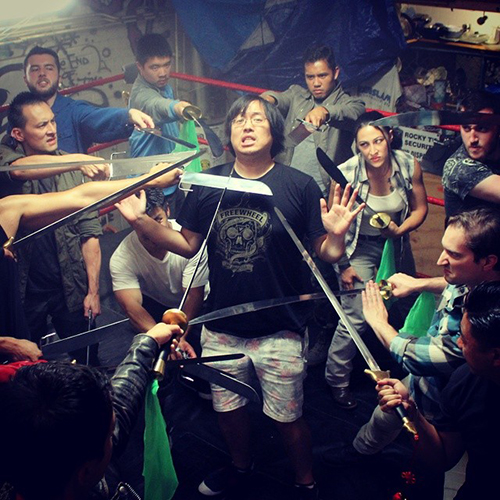 GC: Tell us more about getting robbed at gunpoint.
GC: Tell us more about getting robbed at gunpoint.
EJ: Ah yes. We were shooting the Dope's house exterior in West Oakland, the same exterior as in Rope-A-Dope 1. In the scene, there's a bag lady outside played by Chinese Wushu coach and martial arts star from the 80s Xena Xu. She was our original weapons master. Then out of nowhere a couple 20-year-olds wearing the usual hoodies and blue jeans strolled through the middle of our shoot. We all knew they were up to no good, but our line producer Vicki tried to coax them out of getting any ideas by offering them some food from the craft services table. They took some food and water, asked us what we were up to, and walked away. We all felt like we had done some kind of good deed.
We get through about 30% of the day, about to move into shooting the training montage. There are 10 people surrounding the camera. There's no way to steal this thing without us seeing it happen. We were laughing about something when I heard a voice say, "Don't move" behind me. I turned around and there's one of the guys pointing a silver berretta at my chest from 4 feet away. My martial arts kicked into high gear and I did what every martial artist should do - nothing. His buddy ran through the middle of the film crew, lifted the camera, and ran away. They were gone in five seconds. We found out that two days earlier, another production had been robbed just up the street. We had walked right into a trap.
We settled down, called the police and all that, but the police can't really help with stuff like this. Fortunately the camera was insured and nobody was hurt. A month later we regrouped, hired Chris Villa as our new sword master, used my Sony FS100 since we couldn't get another RED camera in time, and filmed on Treasure Island. This time we brought armed security. But believe it or not, we got cased again! A green car starts driving around with a bunch of thugs looking at our equipment, so I had our security guy JJ just stand in the street with his hand on his sidearm, but these guys just wouldn't go away. They ended up parking up the street and watched us all day. It was really stressful and finally I said, "I'm not comfortable here anymore, let's wrap this up now." We got what we needed and got out of there without losing our camera.
GC: We always here that old disclaimer ‘Don’t try this at home.’ Do you have any safety tips for people who won’t heed that?
EJ: Well... I'd be a hypocrite if I told people, "Don't try this at home." That's exactly what I did when I watched Jackie Chan - I tried all that stuff outside with my buddies! But one thing I didn't know was that Jackie used padding. So for the first two years I did all my wrecks on concrete without any padding. If I can tell people anything, it's "Get some padding before you do this at home."
GC: Did anyone get hurt in production?
EJ: Dennis tore his hamstring in the final fight in the ring, but he toughed it out for 10 hours. Between takes I could see his mind wandering off, but once "Action" was called he'd hop right back into it. Pete also took a cane to the nuts. It's in the outtakes and it's hilarious.
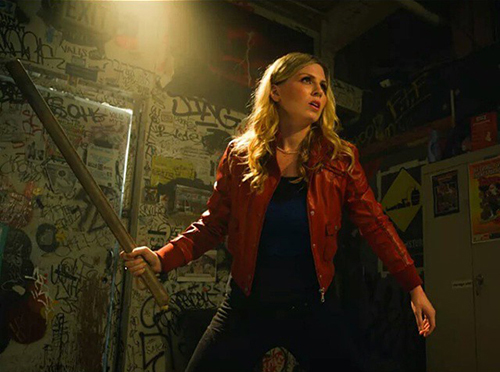
When the fight wrapped Dennis and I both dropped like bricks, him because of his hamstring, and me because my entire body cramped up. I could barely stand. We have footage of it, I look like a newborn deer trying to walk. I went to a restaurant afterward with Clayton and Freddie and I started cramping again. I kicked the table and made a huge scene, flailing about and cussing in this restaurant. I turned around to apologize to everyone and tried to explain but the cramps took over my body and I became a spastic mess! I walked like some crack head and got outside where I dropped to the ground, writhing in pain. Have you ever had your hamstrings, calves, AND quads cramp? People thought I was insane. I think one guy said, "You should lay off the sauce, man." It was a pretty strange way to wrap a shoot.
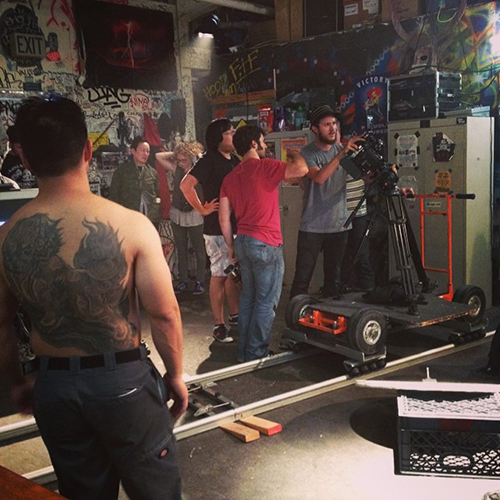 GC: Which fight sequence in Rope-A-Dope 2 was the hardest to shoot and why?
GC: Which fight sequence in Rope-A-Dope 2 was the hardest to shoot and why?
EJ: The pan fight outside before the finale was tough because the pan was so damn heavy. Pulling a pan attack to someone's head and making it look powerful is really hard!
GC: At some point, I think every martial artist dreams of doing fight choreography. What don’t these dreamers know about actually achieving that goal?
EJ: Martial artists often don't realize they already have the technology to achieve their goal. Everything they need is sitting under their noses. Grab your iPhone and a buddy, shoot something, and edit it on iMovie or Windows Movie Maker. That's how I started. I think a lot of martial artists and aspiring stunt performers put unrealistic expectations on themselves. They want their first project to look like a Hollywood film, but my first two hundred short films looked like crap. Put the hours in, and the dream slowly becomes a reality.
GC: Your fight choreography is fun and fresh. Take us through your choreographic creative process. What is your martial muse?
EJ: I was raised on a lot of Vaudeville comedy as a kid. Chaplin, Keaton, W. C. Fields, Marx Bros, and Laurel and Hardy in particular. I'm most in tune with physical gags, so I plant those first. We had a gag in every room for Rope-A-Dope 2. Among the weapons Tiger Claw sponsored there was a martial art cane, which gave me a million new ideas, from Chaplin and Jackie Chan gags to Sammo Hung and Donnie Yen style martial art moves. Throw in a bit of Bartitsu, the Western cane fighting style, and the fights almost wrote themselves. My choreography all revolves around the gags - that's the Jackie Chan influence. Then I connect it all by dipping into the well of combos and cool moves I've gleaned from martial art films.
GC: Name some martial arts fight scenes in recent films that you thought were hot.
EJ: I thought the kitchen fight that John Salvitti put together in Special ID was fantastic. It nailed every character trait we love about Donnie Yen. Jackie did an underrated and spectacular finale in Chinese Zodiac, which also featured some of my favorite indie guys Max Huang, Andreas Nguyen, and David Torok. The knife fight in The Raid 2 was also amazing, and Keanu Reeves is officially an action star after John Wick. The genius of these movies isn't just how proficient the martial arts are. That stuff's just glue, "choreo", "shoe leather". You gotta bring out the magic of the performer. That'll vary from person to person. For example, some indie stunt guys are better off innovating from Donnie's style, but there are so many great role models to innovate from.
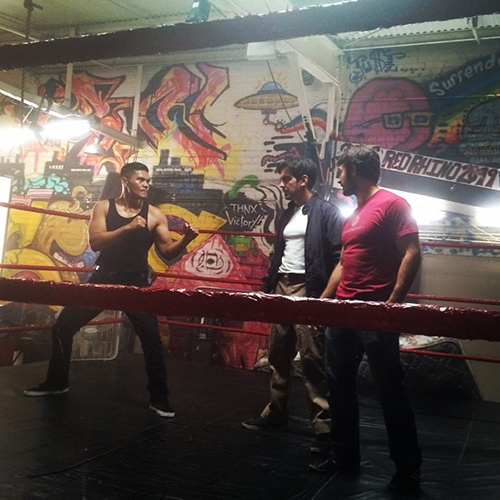 GC: What’s next for the Stunt People?
GC: What’s next for the Stunt People?
EJ: We've got a roster of a few more short films to release this year, including Jose Montesinos' Sensitive 70s Turtleneck Tough Guys. Rope-A-Dope 1 and 2 producer Clayton Barber and I are prepping some more projects too. When we put our heads together, good things always happen. So I'm really excited about this year. I think The Stunt People brand will focus on the stunt team, as Clayton and I are really the production company brand that embodies the spirit we created for the Rope-A Dope films.
GC: What is your hope for these Rope-A Dope short films?
EJ: Aside from making as many people laugh as possible and inspiring more creative talent to go out there and make action movies, I really hope these films put us on the map as, like the philosophy I developed with The Stunt People, "Action guys making action films."
GC: Will there be a Rope-A Dope 3?
EJ: I can't say exactly where the franchise will go next, but The Dope will return.
About
Gene Ching :
![]() For more about Eric Jacobus and the Stunt People, visit thestuntpeople.com.
For more about Eric Jacobus and the Stunt People, visit thestuntpeople.com.
![]() Print Friendly Version of This Article
Print Friendly Version of This Article
















